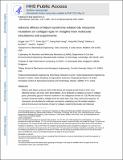Notice
This is not the latest version of this item. The latest version can be found at:https://dspace.mit.edu/handle/1721.1/136103.2
Adverse effects of Alport syndrome-related Gly missense mutations on collagen type IV: Insights from molecular simulations and experiments
| dc.contributor.author | Yeo, Jingjie | |
| dc.contributor.author | Qiu, Yimin | |
| dc.contributor.author | Jung, Gang Seob | |
| dc.contributor.author | Zhang, Yong-Wei | |
| dc.contributor.author | Buehler, Markus J | |
| dc.contributor.author | Kaplan, David L | |
| dc.date.accessioned | 2021-10-27T20:30:49Z | |
| dc.date.available | 2021-10-27T20:30:49Z | |
| dc.date.issued | 2020 | |
| dc.identifier.uri | https://hdl.handle.net/1721.1/136103 | |
| dc.description.abstract | © 2020 Elsevier Ltd Patients with Alport syndrome (AS) exhibit blood and elevated protein levels in their urine, inflamed kidneys, and many other abnormalities. AS is attributed to mutations in type IV collagen genes, particularly glycine missense mutations in the collagenous domain of COL4A5 that disrupt common structural motifs in collagen from the repeat (Gly–Xaa–Yaa)n amino acid sequence. To characterize and elucidate the molecular mechanisms underlying how AS-related mutations perturb the structure and function of type IV collagen, experimental studies and molecular simulations were integrated to investigate the structure, stability, protease sensitivity, and integrin binding affinity of collagen-like proteins containing amino acid sequences from the α5(IV) chain and AS-related Gly missense mutations. We show adverse effects where (i) three AS-related Gly missense mutations significantly reduced the structural stability of the collagen in terms of decreased melting temperatures and calorimetric enthalpies, in conjunction with a collective drop in the external work needed to unfold the peptides containing mutation sequences; (ii) due to local unwinding around the sites of mutations, these triple helical peptides were also degraded more rapidly by trypsin and chymotrypsin, as these enzymes could access the collagenous triple helix more easily and increase the number of contacts; (iii) the mutations further abolished the ability of the recombinant collagens to bind to integrins and greatly reduced the binding affinities between collagen and integrins, thus preventing cells from adhering to these mutants. Our unified experimental and computational approach provided underlying insights needed to guide potential therapies for AS that ameliorate the adverse effects from AS disease onset and progression. | |
| dc.language.iso | en | |
| dc.publisher | Elsevier BV | |
| dc.relation.isversionof | 10.1016/J.BIOMATERIALS.2020.119857 | |
| dc.rights | Creative Commons Attribution-NonCommercial-NoDerivs License | |
| dc.rights.uri | http://creativecommons.org/licenses/by-nc-nd/4.0/ | |
| dc.source | PMC | |
| dc.title | Adverse effects of Alport syndrome-related Gly missense mutations on collagen type IV: Insights from molecular simulations and experiments | |
| dc.type | Article | |
| dc.relation.journal | Biomaterials | |
| dc.eprint.version | Author's final manuscript | |
| dc.type.uri | http://purl.org/eprint/type/JournalArticle | |
| eprint.status | http://purl.org/eprint/status/PeerReviewed | |
| dc.date.updated | 2021-05-06T18:24:12Z | |
| dspace.orderedauthors | Yeo, J; Qiu, Y; Jung, GS; Zhang, Y-W; Buehler, MJ; Kaplan, DL | |
| dspace.date.submission | 2021-05-06T18:24:14Z | |
| mit.journal.volume | 240 | |
| mit.license | PUBLISHER_CC | |
| mit.metadata.status | Authority Work and Publication Information Needed |
